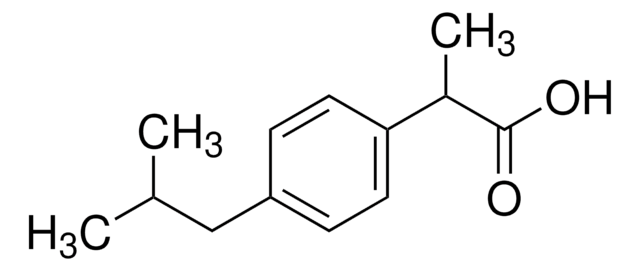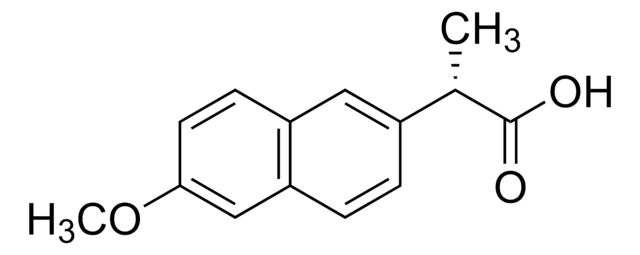1457403
USP
Naproxen sodium
United States Pharmacopeia (USP) Reference Standard
Sinónimos:
(S)-6-Methoxy-α-methyl-2-naphthaleneacetic acid sodium salt
About This Item
Productos recomendados
grade
pharmaceutical primary standard
API family
naproxen
manufacturer/tradename
USP
application(s)
pharmaceutical (small molecule)
format
neat
SMILES string
[Na+].COc1ccc2cc(ccc2c1)[C@H](C)C([O-])=O
InChI
1S/C14H14O3.Na/c1-9(14(15)16)10-3-4-12-8-13(17-2)6-5-11(12)7-10;/h3-9H,1-2H3,(H,15,16);/q;+1/p-1/t9-;/m0./s1
InChI key
CDBRNDSHEYLDJV-FVGYRXGTSA-M
Gene Information
human ... PTGS1(5742) , PTGS2(5743)
¿Está buscando productos similares? Visita Guía de comparación de productos
General description
Application
- Naproxen Sodium and Pseudoephedrine Hydrochloride Extended-Release Tablets
- Naproxen Sodium Tablets
Biochem/physiol Actions
Analysis Note
Other Notes
Related product
signalword
Danger
hcodes
Hazard Classifications
Acute Tox. 4 Oral - Repr. 1A
Storage Class
6.1C - Combustible acute toxic Cat.3 / toxic compounds or compounds which causing chronic effects
wgk_germany
WGK 3
flash_point_f
Not applicable
flash_point_c
Not applicable
Certificados de análisis (COA)
Busque Certificados de análisis (COA) introduciendo el número de lote del producto. Los números de lote se encuentran en la etiqueta del producto después de las palabras «Lot» o «Batch»
¿Ya tiene este producto?
Encuentre la documentación para los productos que ha comprado recientemente en la Biblioteca de documentos.
Nuestro equipo de científicos tiene experiencia en todas las áreas de investigación: Ciencias de la vida, Ciencia de los materiales, Síntesis química, Cromatografía, Analítica y muchas otras.
Póngase en contacto con el Servicio técnico







